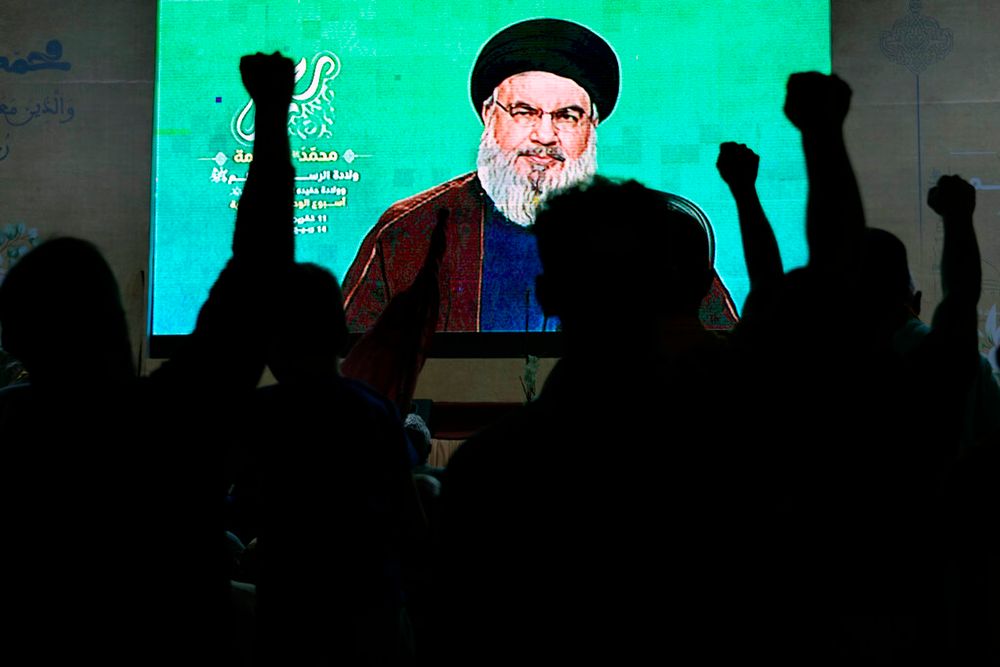News
Hezbollah Leader Threatens to Sink US War Ships With Russian Missiles

Hezbollah leader Sayyed Hassan Nasrallah has warned the United States that his group had something in store for US Navy ships stationed in the region following the outbreak of war last month between the Palestinian party Hamas and Israel, which shook the wider Middle East.
According to individuals acquainted with Hezbollah’s arsenal, powerful Russian anti-ship missiles purchased by the group provide it with the means to carry out its leader’s veiled threat against US warships and highlight the dire hazards of any regional war.
According to two individuals in Lebanon acquainted with Hezbollah’s arsenal, he was alluding to the group’s considerably upgraded anti-ship missile capabilities, which include the Russian-made Yakhont missile with a range of 300 km (186 miles).
According to media and analysts, Hezbollah obtained Yakhont missiles in Syria after deploying there more than a decade ago to assist President Bashar al-Assad in fighting a civil war.
Hezbollah has never admitted to having the weapon.
When contacted for comment on this article, the Shi’ite group’s media office did not react promptly.
Washington claims that the Mediterranean naval deployment, which includes two aircraft carriers and supporting ships, aims to prevent the crisis from spreading by discouraging Iran, which supports groups such as Hamas, Hezbollah, and Palestinian Islamic Jihad.
Because of their ability to strike the group and its allies, Hezbollah sees the US warships as a direct danger.
In a speech on Friday, Nasrallah stated that US warships in the Mediterranean “do not scare us, and will not scare us.”
“We have prepared for the fleets with which you threaten us,” he went on to say.
Following Nasrallah’s Friday statement, the White House stated that Hezbollah must not exploit the Hamas-Israel confrontation, and that the US does not want the conflict to spill over into Lebanon.
According to one of the sources, Hezbollah’s anti-ship capabilities have grown dramatically since 2006, when the group displayed its ability to strike a vessel at sea by hitting an Israeli destroyer in the Mediterranean during a fight with Israel.
“There’s the Yakhont, and of course there are other things besides it,” the insider stated, without going into further detail. The use of this weapon by Hezbollah against US Navy warships would signify that the situation has evolved into a major regional war.
Hezbollah’s capabilities
According to three current and one former US officials, Hezbollah has developed an outstanding arsenal of weaponry, including anti-ship missiles.
“We’re obviously paying a lot of attention to that… and we’re taking whatever capabilities they have seriously,” one official added, without specifically addressing whether the organisation has the Yakhont rocket.
The officials talked anonymously in order to speak openly about Hezbollah’s capabilities.
According to US sources, the recently deployed US naval strength in the region includes defences against incoming missiles. They didn’t go into detail.
The Pentagon has sent warships to the eastern Mediterranean since Oct. 7, when Hamas terrorists assaulted Israel from the Gaza Strip, killing 1,400 people, according to Israel.
According to Palestinian sources, Israeli attacks on the Gaza Strip have killed over 10,000 Palestinians since then.
Nasrallah cautioned Washington on Friday that stopping the Israeli onslaught was critical to avoiding a regional war. Since October 8, Hezbollah has been exchanging fire with Israeli forces along the Lebanese border.
However, Hezbollah has only deployed a portion of its weaponry thus far, and the fighting has primarily been limited to the border area.
Iran backed militants
Other Iran-aligned groups, such as Yemen’s Houthis, have also shot drones at Israel, while Shi’ite Muslim militias backed by Iran have fired on US forces in Iraq and Syria.
According to Reuters the Washington-based Centre for Strategic and International Studies (CSIS), the ground-launched Yakhont approaches its target at low altitude – 10 to 15 metres (yards) off the ground – to escape detection.
According to CSIS, the Yakhont missile, a version of the P-800 Oniks missile first created in 1993, was developed in 1999 for export by a Russian defence contractor and may be launched from the air, land, or submarines.
When asked about the sources’ claims that Hezbollah had obtained Yakhont missiles, Kremlin spokesman Dmitry Peskov stated, “First and foremost, this is news with no confirmation.” We don’t know if it’s true or not.”
“Secondly, we do not have such information.”
The Russian defence ministry did not respond to a written request for comment. The Syrian information ministry did not immediately respond to Reuters’ emailed inquiry.
Nasrallah’s Friday speech was one of his strongest warnings to the US, which holds his group responsible for a suicide attack that destroyed the US Marines headquarters in Beirut in 1983, killing 241 servicemen, as well as a suicide attack on the US embassy that same year, killing 63 people.
While Hezbollah has claimed responsibility for the assaults, Nasrallah alluded to them implicitly in his speech, saying people who beat the US in Lebanon in the early 1980s were “still alive.”
In remarks aired last month on his private YouTube channel, Nasser Qandil, a Lebanese political analyst close to Hezbollah, outlined how the group’s Yakhont missiles could be used against US vessels.
He called the rocket “the most important prize” of Hezbollah’s role in Syria’s civil war, where the group helped turn the tide in Assad’s favour.
“Yes, Hezbollah is prepared and ready,” stated Qandil.
According to two people who spoke to Reuters, Hezbollah got the weapon while fighting in Syria in support of Assad, whose force has long been supported by Russia.
Hezbollah maintains its stockpile and the sources of its weapons under wraps. Nasrallah detailed how the group received Russian-made Kornet anti-tank missiles through Syria in rare statements on the subject in 2021.
News
King Charles Could Millions Annually from Renting His Properties

A recent analysis suggests that King Charles might earn over £1 million each year by renting out royal properties to holidaymakers.
The Royal Family’s historic houses and mansions are popular holiday rentals, contributing significantly to the Palace’s revenue.
Pikl Insurance estimates that the royals may earn up to £118,775.85 per month, or around £1,425,310.20 per year, from their holiday rental portfolio. Even after accounting for cancellations, the monarchy is anticipated to generate a net annual income of somewhat more over £1.4 million.
Estimated Annual Rental Income of £1.4 Million
The four primary royal properties accepting public bookings are Balmoral Castle, Castle of Mey’s Captain House, Restormel Manor, and Dumfries House, according to Express.co.uk. Cottages at Balmoral Castle in Scotland are expected to generate £36,798.30 per month after accounting for cancellations.
According to the numbers, the 500-year-old Restormel Manor in Cornwall is the most profitable of them all, earning a solid £47,082 every month. The resort, located in the Fowey Valley, has four booking spaces and six converted barns.
Dumfries House in Ayrshire, Scotland, adds an estimated £31,185.63 and offers 25 rooms for booking. The Castle of Mey’s Captain House in the Scottish Highlands is estimated to generate a more modest £3,709.92 per month, despite the fact that the entire property is available for booking.
The analysts stated, “While the Royal Family’s primary role is undoubtedly to serve the nation, it is clear that their properties are also a valuable asset.” These estimates highlight the royal estate’s considerable financial potential and provide an intriguing peek into the monarchy’s corporate operations.”
Royal Family received £86.3 million from the taxpayer-funded Sovereign Grant in the previous fiscal year, according to official numbers released in July.
All revenues from the Crown Estate, which includes royal households, forestry, agriculture, and offshore wind, are paid directly to the Treasury, with a portion of this money, now 12%, returned to the Royal Family to finance their tasks.
The records also cover a period of jubilation, including the coronation and festivities surrounding the King and Queen’s crowning in May of last year.
News
Man Creates Candy Cane Car to Spread Christmas Cheer

In a delightful display of holiday spirit, a local resident in North Providence, Maine, has transformed his vehicle into a candy cane delight that is capturing hearts and spreading Christmas Cheer.
Over the past 15 years, Dave Clayman has transformed a simple 1991 Toyota Camry into a rolling holiday icon that captivates everyone who encounters it.
It’s wrapped in $3,000 worth of reflective tape, the same kind used on trailer trucks. Whether parked at a mall or cruising down the highway, you can’t miss it with its candy cane decorations.
This whimsical project started with an unusual idea. When an old exercise bike landed in Clayman’s possession, he mounted it on top of his car instead of letting it gather dust in his garage.
“There’s nothing like working out in the fresh air,” Dave said. That quirky addition quickly drew eyes, inspiring him to keep going.
The car features homemade rockets built from trash cans and salad bowls, candy cane-themed hubcaps, and candy cane lights dangling from the mounted exercise bike.
The Candy Cane Car cost Clayman $3,000
To top it off, it boasts a PA system and a custom horn, making it a true sensory experience.
The candy cane car has now become a local landmark every Christmas. Parked outside Clayman’s house, it’s a favourite backdrop for people snapping photos or simply stopping to admire it.
Some visitors even share stories of seeing the car as a child, reminiscing about how it’s been a beloved part of their neighbourhood for years.
“When people see it, their mood amplifies,” Clayman explained. “If they’re happy, they become happier. If they’re upset, well, they sometimes get angrier.” But for the most part, he estimates that over 96% of people love the festive car, particularly around Christmas.
Clayman said he used to wear a Santa costume when riding in his festive car for years. A few years ago, he bought a Grinch costume and never looked back.
“It’s like a state of euphoria. Every time I get behind the wheel and people see it,” he said. “Anything that people are in a better mood, it seems to make you in a better mood. It’s a labor of love you got to be committed to it.”
Related News:
Costco Is Offering The Peloton Bike+ At 300 Locations This Holiday Season.
News
Senate Approves Social Security Fairness Act, Heads to Final Vote

(VOR News) – On Wednesday, the United States Senate Social Security passed a measure with a vote of 73-27, indicating that the legislation, which is co-sponsored by Senator Susan Collins of Maine, is likely to be implemented before the end of the year.
The law may be beneficial to personnel working in the public sector in Maine, including teachers, firefighters, and other workers.
The Social Security Fairness Act would repeal two restrictions that lower the amount of Social Security payments paid to public employees.
These regulations would be eliminated with the passage of the act. A provision known as the Windfall Elimination Provision makes it impossible for public employees who are currently receiving pensions to continue receiving them.
The Government Pension Offset, as it is commonly referred to, is designed to limit the amount of money that can be paid to the surviving spouses of recipients who are also receiving government pensions.
This problematic situation impacts Social Security benefits.”
In November 2024, the Social Security Administration reported that more than 2 million individuals, including more than 20,000 in the state of Maine, had their Social Security benefits reduced as a result of the Windfall Elimination Provision,” Collins stated in a statement that was released by her department.
In November 2024, the Government Pension Offset had an impact on more than 650,000 individuals, with more than 6,000 of those individuals residing in the state of Maine, according to the previously mentioned line of reasoning.
A vote of 327 to 75 was necessary for the measure to be approved by the House of Representatives the previous month. On Wednesday, Chuck Schumer, the Democratic leader of the Senate, announced that he intended to work rapidly in order to deliver the act from the House of Representatives to the president’s desk.
As indicated by Schumer, who was speaking on the floor of the United States Senate today, “Passing this Social Security fix right before Christmas would be a great gift for our retired firefighters, police officers, postal workers, teachers, and others who have contributed to Social Security for years but are now being penalised because of their time spent serving the public.”
In the beginning, the measure was supported by two individuals: Sherrod Brown, a Democrat from Ohio, and Collins, a Republican. During her speech in support of the proposal, which was made on the floor of the Senate on Wednesday afternoon, Collins stated that the idea will have a significant impact on a number of individuals, including teachers in the state of Maine.
These advantages are the direct result of the effort that they put forth. During the course of her remarks, Collins asserted that the punishment in question was both unreasonable and unacceptable.
This will strain Social Security’s already shaky budget.
In a recent examination, it was discovered that the Windfall Elimination Provision was one of the primary problems that contributed to the difficulties that the teacher workforce in Maine is experiencing, which experts are referring to as a crisis.
A poll that was conducted and released by the non-profit organisation Educate Maine found that teachers in each and every county in the state of Maine identified the provision as a hindering factor in the process of recruiting new teachers.
According to the findings of the study, “this federal policy that reduces social security payouts is a disincentive,” which implies that it is detrimental to teachers who take on additional work and discourages people from switching careers in order to become teachers.
Sharon Gallant, a retired educator who worked in Gardiner for a total of 31 years, is one of the educators that are now employed there. Prior to beginning his career as a teacher in the public school system, Gallant was employed in the business sector. He made a little contribution to the Social Security system during the entirety of this time period.
“When you move into public education, you are faced with a certain degree of punishment,” according to her statement.
In letters that Gallant sent to Collins and to Sen. Angus King of Maine, who is an independent, he urged both of them to support the concept. She stated that even if it is unsuccessful, Maine will still have a difficult time recruiting teachers because of the clause that deters them from employment.
She made the observation, “If this does not pass, then it is just another reason not to enter public service.”
SOURCE: FR
SEE ALSO:
The Federal Reserve Will Drop Key Rates, But Consumers May Not Gain Immediately.
Canadian Dollar Hits Multi-Year Low Over Political Unrest
-
Politics3 weeks ago
Miller Expects 4.9 Million Foreigners to Leave Canada Voluntarily
-
News3 weeks ago
Nolinor Boeing 737 Crash Lands in Montreal
-
News2 weeks ago
“Shocking Video” Vancouver Police Shoot Armed Suspect 10 Times
-
Tech3 weeks ago
Increasing its Stake in OpenAI by $1.5 Billion is a Possibility for SoftBank.
-
News4 weeks ago
Facebook Securities Fraud Case Dropped
-
Health4 weeks ago
A Canadian Teenager’s Bird Flu Virus Has Mutations






























